The Forgotten Crash Of
1950
The
first F-86s to land at Kanawha Airport, crashed just 3 minutes after
takeoff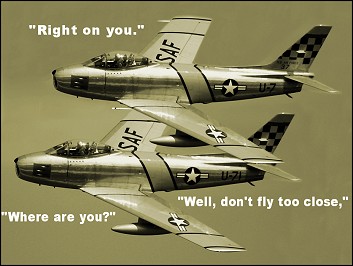 March
22 1950 was a cloudy overcast day in the Kanawha valley with drizzle in
the air. On this day two F-86 jets were warming up at Kanawha
Airport ready for takeoff. These were the first F-86's to ever
land here, as production jets of any type had only been in
operation for about two years. The reason these jets had landed
the day before was sort of an emergency in itself: They had run
low on fuel. Because of the scarcity of jets and jet fuel,
the pilots would have to wait for fuel to be delivered from Dayton Ohio
the following day. So, Lt. Col. A.F. Reinhardt (43) and
Capt. George Evans (28) spent the night in Charleston, and even visited
the old "Press Club" during their stay. March
22 1950 was a cloudy overcast day in the Kanawha valley with drizzle in
the air. On this day two F-86 jets were warming up at Kanawha
Airport ready for takeoff. These were the first F-86's to ever
land here, as production jets of any type had only been in
operation for about two years. The reason these jets had landed
the day before was sort of an emergency in itself: They had run
low on fuel. Because of the scarcity of jets and jet fuel,
the pilots would have to wait for fuel to be delivered from Dayton Ohio
the following day. So, Lt. Col. A.F. Reinhardt (43) and
Capt. George Evans (28) spent the night in Charleston, and even visited
the old "Press Club" during their stay.
|
The
two were veteran pilots of the war, and were based out of
Kirkland Field, Albuquerque New Mexico.
At
around 12:19 pm on March 22nd, the jets roared down the runway in
formation almost wingtip to wingtip. The Press covered the event
live, including a radio station. About 3 minutes later,
both jets crashed into the ground at 500 miles per hour near the Coal
River town of Emmons WV. One jet entered the earth vertically,
blowing a hole over 10 feet deep and 30 feet across. The other
hit about 300 feet up the hill at less than vertical, but still
digging a huge hole in the earth. The resulting double crash was
so violent that only a few larger pieces were recovered and those could
be carried away by one man. The crash of one jet was about
100 feet from a house in which three people were home. One was a
baby named Jean Parcell, and she lives in the same house today.
The following are reports of the event. Be aware that some misinformation was printed
as is the case with almost all disaster stories. This was later
corrected or inconclusive...
|
 This photo shows the jets on
the ground at Kanawha Airport.
This photo shows the jets on
the ground at Kanawha Airport.
I believe that's one of the pilots looking into the cockpit, and
possibly the other on the ground.
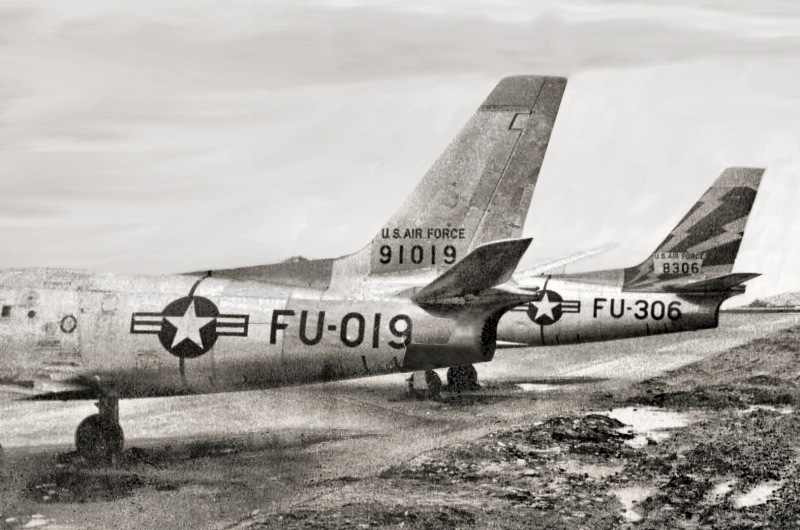 Kanawha Airport was still
brand new at this time, with more improvements on the way.
Kanawha Airport was still
brand new at this time, with more improvements on the way.
(The above two photos courtesy of Yeager Airport Archives)
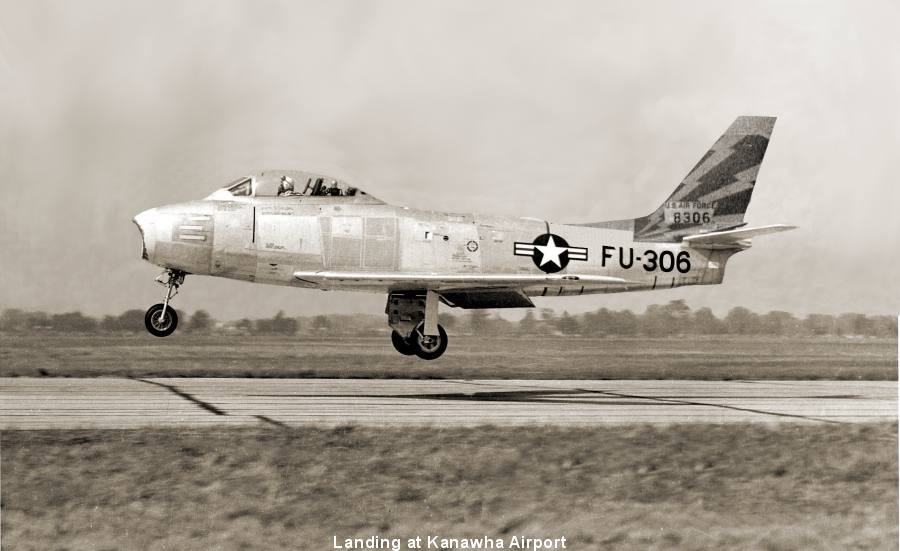
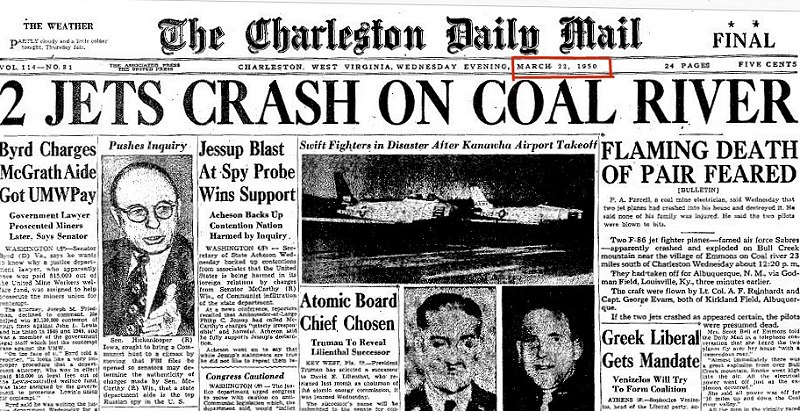

The following
is from the Charleston Gazette, March 23rd 1950
Jets Fall;
Pilots Die In Crash
|
Two
Air Force F-86 jet fighter planes crashed yesterday in a rugged
mountain section about 20 miles from here, killing both pilots. Time of
the crash was set at 12:19 p.m., less than two minutes after the two
planes took off from Kanawha Airport.
An eye-witness said the two planes brushed wings at
about 5,000 feet and plummeted downward, disintegrating as they hit the
earth with a deafening explosion that severely damaged a house 50 yards
away and blew the pilots to bits.
The two pilots were identified as: Lt. Col. A. F.
Reinhardt, 43, a native of Huntington, Long Island, N. Y., and Capt.
George W. Evans, Jr., 28 of Laurel, Miss.
The scene of the crash was Gripp Station on Coal River, a small hamlet
about a mile from Emmons, the nearest post office.
The two crafts were en route to Maxwell Air Force Base, Montgomery,
Ala., from Washington, D. C., and they were to proceed to Kirtland
Base, Albuquerque, N. M. A fuel shortage had forced the two to make an
emergency landing Tuesday at the Charleston field to await shipment
from Dayton, Ohio.
Eye witnesses said the planes exploded in a blinding flash as they
struck the ground. They fell about 50 yards apart on the hillside,
tearing out great chunks of earth. A two-feet square piece of a
fuselage was the largest fragment of either plane that was found. Only
a few scattered pieces of either man could be located in the wreckage.
Small pieces of clothing and wreckage were blown over a half-mile area.
A house about 60 yards from the crash scene was nearly blown from its
foundation by the force of the explosion. Owner of the house, P. A.
Parcell, a 41-year-old coal miner, said his house was badly damaged by
the blast. A metal piece of one plane was blown completely through one
wall into the living room. Present in the house at the time was
Parcell's wife, Vivian, his three-month-old daughter, Jean, and an
uncle, J. E. Whittington. Whittington said he was standing at a kitchen
window when the planes hit and erupted in a blinding flash. "I saw a
flash," he said, "then all of a sudden the window blew out and the dirt
started flying in my face." Whittington said he was scared so
badly that he ran into another room, closing the door behind him.
Mrs. Parcell said she thought lightning had struck the
house and immediately grabbed up her baby and ran from the house. "When
I reached the road in front of the house," she said, "1 looked up on
the hill back of the house and saw the two fires, pieces of stuff were
flying all through the air."
Apparently the only eye witness to the actual crash was bearded *
Wheeler Holstein, a farmer who resides in a remote section about three
miles from the scene. "I was shoveling coal in from a truck into
my house." he said "when I looked up and saw those planes flying
together across the valley." All of a sudden," he said, "I saw their
two wings come together and they started falling toward the ground
across the mountain." Holstein said he also saw smoke pouring from the
rear of the two planes, which is believed to have been their jet
trails. Holstein described the event to a Gazette reporter who had
climbed to the top of the towering mountain in search of a scene of the
crash.
Shortly after the two ill-fated planes took off yesterday, the Kanawha
Airport radio tower cracked with inter-communication between the two
departing fliers:
"Where are you?" asked one voice, believed to have been Col.
Reinhardt.... "Right on you." Came the reply.... "Well,
don't fly too close," came the retort.
That
was the last heard from the two men as they traveled approximately 600
miles an hour in the two craft, described as "Sabre" fighter planes.
Early
reports that the planes had struck a power line were discounted by
State Police and Army officials, who pointed out that the line was
about 300 yards below the top of the mountain over which the two jets
flew. Power line No. 5 carrying 66,000 volts from the Cabin creek power
plant to the South Charleston Naval Ordnance plant, was severed as the
planes plunged earthward. A 10 mile area around the crash scene was
without electric power. |
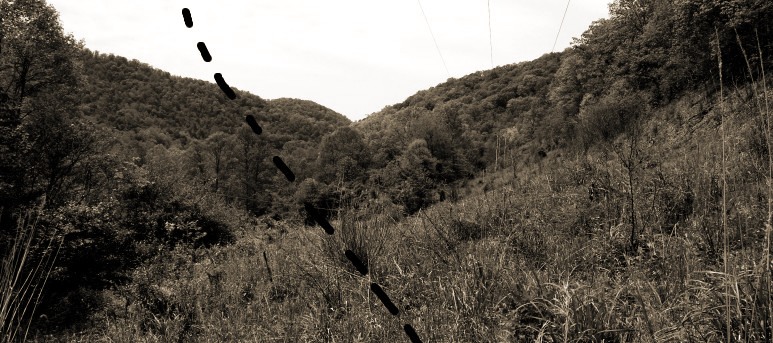
|
There were no broken limbs on trees from the top of the
mountain to the place where the planes exploded into the ground,
indicating that they plummeted vertically to the earth after their
wings came together in the air.
Late last night an Army board of Inquiry was reported en route from
Wright-Patterson Air Force Base at Dayton, Ohio, to make a formal
investigation of the crash.
In response to a request for information, Air Force
headquarters in Washington, D. C. said Col. Reinhardt graduated from
Arlington, N. J. high school in 1921, worked for the Sanders Reinhardt
Co. in Allentown, Pa., from 1927 to 1937, was an employee of the
Washington D. C. Post newspaper before entering the Air Force in
1942. Reinhardt's wife is Mrs. Carole Reinhardt. Capt. Evans was
a flight lead of the 93`d Fighter Squadron of the 81st Fighter Group at
Kirtland Field, Albuquerque, N. Mex.
Evans attended school at Ellisville, Miss. His mother, Mrs. Etta H.
Evans, resides at Laurel. Reinhardt served with the 15th Air Force
during World War II and from 1947 to last August was stationed at
Wheeler Field: Hawaii. Evans served with the 9th Air Force during the
war and was stationed afterwards at Wheeler Field.
Results of crash were summed up in terse report of Cpl. Cohen to his
headquarters in which he said "only a handful of the pilots was
found." The remains will be at Cunningham mortuary, pending
further orders from Air Force officials.
Ironically, the same day of the crash, the Air Force announced the 815t
Fighter Interceptor Wing to which both pilots were attached, was being
ordered to the Pacific Northwest to protect key defense installations.
|
|
Reports
were printed in both the Charleston Gazette and Daily
Mail newspapers on the day before and several days after the above
article, including this eyewitness report from Adrian Gwin, a
veteran reporter for the Daily Mail, who said the scene of the crash
was an "awesome and spectacular sight"....
"There
are pieces of bodies and the two planes over an area of roughly four
square acres. "I saw two feet severed just above the ankles, the
largest part of any body remaining. "One plane hit beside a small dirt
road at a community known as Grippe, which is half a mile from Emmons.
The other hit 200 yards away up the slight slope of a hill. "Both
planes made craters roughly 40 feet square and about 10 feet deep. "I
saw a torn patch bearing the name of Lt. Col. Reinhardt. It was a crash
pass that would permit him to go through police lines when crashes
occurred so that he could investigate. "I saw torn bits of clothing and
little pieces of flesh, including a part of an arm, part of a scalp and
a bit of a shoulder. "There were scattered bits of maps and papers.
"There was no piece of the planes left that could have been carried
away."
|
So how did I come upon this
forgotten story?

Me and Dick Miller
checking out the crash site
| I had heard bits and pieces of this
story over the last 30 years from a couple of friends who were actually
at the crash site when it happened. One was Danny Davidson... the
other Dick Miller. At the time Danny told me a bit about the
crash, it was (to me) like all the other crashes that have
happened in our area: hard to locate now, or hard to get to.
But in the summer of 2008, Dick Miller mentioned (almost in
passing) about the crash as we were talking about the Ashford WV
area. As I had just driven right past the crash site and didn't
realize it, I asked Dick to help locate the exact area.
Naturally, Emmons is a tiny spot in the road and I simply could have
asked anyone old enough, and they would have pointed it
out. But I wanted the man who actually helped pick up the pieces
of the crash to join me in my mini adventure. As we pulled into
the exact spot, Dick said it looked right. He was
dead-on. We later located the property owner and toured the area
where the two jets buried themselves. One site near the road was
now grown over with vegetation. This is the spot where the jet
went straight-in and buried deepest. They basically shoveled dirt
over it, as there was nothing left to recover. |
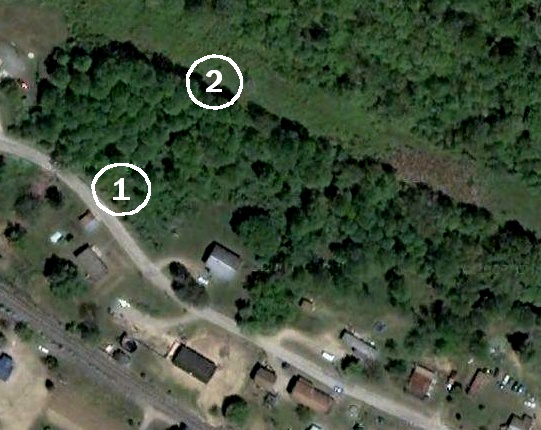
BEFORE
I GO ANY FURTHER .....
|
Be
aware that these crashes took place on PRIVATE
PROPERTY. The property owners are VERY private people...
good country folk that like most.... are hesitant to have strangers
appearing out of nowhere to bother them and trample their
land. My connection is my friend Dick, who's family knew
the property owners. So take my advice and don't bother these
people as they simply wont allow complete strangers on their property
for the purpose of looking for relics or anything else.
Understood? Great.
On
the first day I took some photos. On my second visit I brought my
metal detector. The second spot further up the hill was the
key, as this jet came in at a slightly more horizontal angle and
scattered debris for hundreds of yards. The depression is still
visible in the ground after 58 years.
|
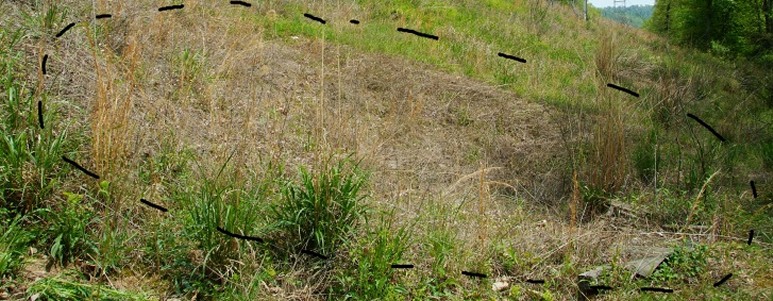
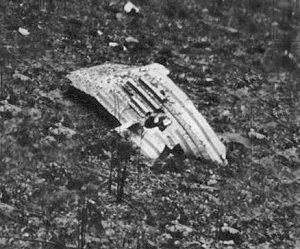
This is
the largest piece of either aircraft that they found.
|
Just as I imagined, at the second site I located
hundreds of pieces of aircraft, mostly two inches long or
less. (I
didn't need to dig these up as my detector tells me how large and how
deep something is.) I looked at a couple of pieces anyway just to
see if they looked burned or not. They didn't. I
looked a little longer and hit a signal that looked interesting.
I started digging and saw the end of a piece, that continued
further. I finally removed it and discovered that
stretched-out, was about 2 feet long. The property owner
told me that it was the largest piece recovered since the initial crash
58 years ago. I brought it home and cleaned it up, and
after studying this mangled piece, I first thought it was part of
the pilots seat, but then discovered that it's part of the wing
seal. (I
had no idea that old jets used nylon fabric this way)
|

A couple of
background stories..
|
Dick
Miller is
known to many people in the Kanawha Valley and beyond. A former
pilot and business owner, Dick has lead a pretty exciting
life. On the day of the crash, Dick was a young worker at a
local brick plant on MacCorkle Ave in Charleston. He and a friend
were listening to a live broadcast on the radio of the jets about to
take-off from Kanawha Airport. As the jets flew over his
head, the noise was deafening. However, due to the
heavy overcast, he couldn't see the jets in tight
formation. A couple of minutes later, the radio announced
that the jets had crashed near Emmons. Dicks co-worker asked him
if he knew where Emmons was. He said "sure... I have family
there". So they got into a truck and started out to the
site, where they arrived just as the National Guard was pulling
in. The smoke was still heaving in the air as the National Guard
commander barked orders to his men (and anyone interested) to help pick
up the pieces. Dick jumped in and assisted all afternoon.
He told me that the thing he never forgot was a chicken coop,
only feet from the site that survived, along with the chickens
inside. On the chicken wire surrounding the coop was hanging tiny
pieces of the pilot, to which the chickens were pecking.
It's been learned also that that no one around would buy the chickens
eggs after the crash.
Danny
Davidson is
also well known in his circles. Danny took off for the crash site
on his BSA motorcycle about 20 minutes after the announcement.
Due to the now heavy traffic on the very narrow road, Danny had
to take to the railroad tracks to make his way to the scene.
Earl
Benton and Chet Hawes of the Daily Mail were there also. They both
arrived early enough to see the National Guard pull in. Earl took
many photos for the paper, while Chet didn't have a camera with
him because he was only at the Paper looking for a job that day.
When the crash came in, the Editor told Chet to ride along with
photographer Ray Wheeler. When Chet returned, he was hired
on the spot and spent the next 40 some years at the Daily Mail.
I'm
sure there were others there that I would later know.... but I
wouldn't be born for 6 months.
|
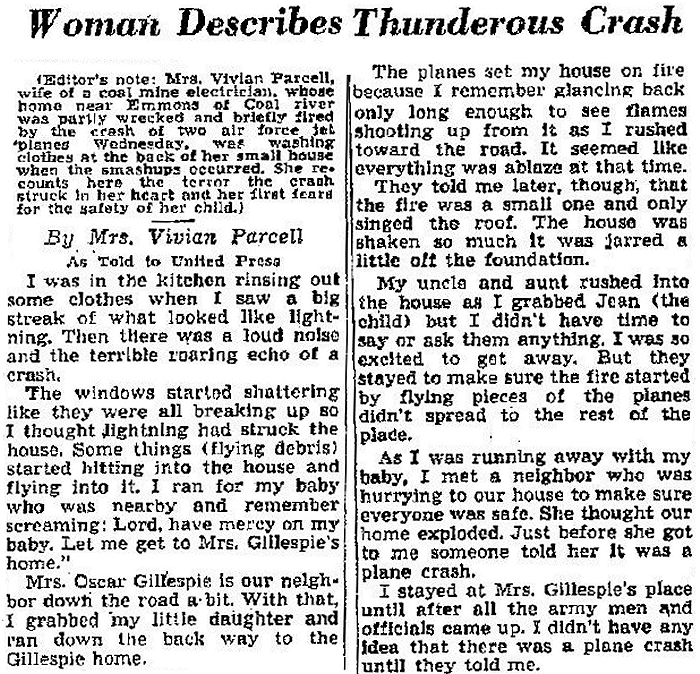
My Opinion on the cause
of the crash....

|
1....
The pilots took-off in very close formation. Why? In my opinion, the
Media. There was Press all over the place and even a live radio
broadcast. The pilots I think, wanted to put on a good show
with these brand new jets that very few people had ever seen in early
1950. However, experts that I have talked to state that it
was standard operating procedure for all military fighter aircraft to
always fly in formation. This seems rather odd considering the
weather conditions on this day, but who knows...
2...
The weather was marginal. The sky's were cloudy and overcast. It was
even drizzling rain. When the pilots "hit the soup" that close
together, one simply became disoriented and "possibly" struck the
other. One rumor that's been going around for years is that one
pilot got Vertigo and the other pilot followed him in to the
ground. This was even mentioned in the newspaper early-on as a
"possibility". But it was never proven. However, I can't
discount some sort of visual interference along these lines
due to the proximity of the aircraft as they crashed at almost exactly
the same second... and the fact that they both came-in nose
first. A mid-air collision of any type shouldn't have allowed for
this pattern. In other words, one plane should have struck the
ground before the other, AND in a different attitude had they
collided in the air. Moreover, it's hard to understand why
they didn't eject at 5000 feet IF they had collided. Even
if they'd wasted time trying to determine damage, they still
should have been able to eject in the "approximately" 10 seconds or so
they had left. So why didn't they even try? It appears that
they FLEW the planes into the ground, so it's really difficult to
determine the actual cause of the crash. Also remember
that the pilots spent part of the previous evening at Charleston's
famous "Press Club". These were hard core fighter pilots who had
just left WWII behind a few years ago. Did they have a little bit
too much fun the night before? Could that have affected one or both in
any way... especially considering the marginal weather conditions? We'll never
know..... and really, some 58 years later it doesn't
matter. What matters is that many pilots wound-up giving their
lives in the pursuit of safer aviation. Many had to die in order
for us to be able to learn from their mistakes ... both man and
machine, and arrive at the place we find ourselves today,
where flying around the world on jets is no different than driving your
car to the supermarket.....
|
I
studied every article written.. too many to post here. And they
all agree with two things:
OFFICIAL FINDING
AT THE TIME....

| "It was certain that the accident
occurred so swiftly and at such a low altitude that neither pilot had
an opportunity to use the F-86 ejection mechanism that catapults the
pilot from the single-seater craft 80 feet into the air and gives him
an opportunity to use a parachute when trouble is encountered." |
FINAL REPORT OF THE CRASH
|
Two
F-86s with Lt Col Reinhardt leading the formation takeoff,
departed Kanawha County Airport, Charleston, WVa at
1217E (12:17pm) for an intended, 500 foot on-top IFR flight,
direct to Maxwell Field. Lt Col Reinhardt in F-86 Number 49-1019
was leading. Captain Evans in F-86, number 48-306 was on
Lt Col Reinhardt's right wing.
At 1220E (12:20pm) they crashed into a mountainside fifteen miles south
of the Kanawha County Airport, 3/4 of a mile east of Emmons, WVa
Eye witnesses at the scene of the crash stated that they
were in a gentle turn to the left, and a slight descent, which
steepened just before impact. Both pilots were killed in the crash.
The wreckage of both aircraft was scattered to the
northeast of the impact point for a distance of approximately 3000
feet. No part of the wreckage was greater than five or 10 pounds.
The weather at the time of the crash was estimated 3000 overcast, 4 to
5 miles visibility in fog and light rain showers.
Both pilots were well qualified in fighter type aircraft
and in instrument experience. Both held currently valid green
instrument certificates.
It
is impossible to determine the exact cause of the accident. The most
probable cause is that the lead pilot experienced vertigo.
|
Here is
just one of a dozen eye witness reports that I
have acquired from the official 108 page government report:
|
T E S T
I M O N Y of Million J. Bock ,
given to Captain James G, Kuntz and
Captain Vernon R. Stutta, 25 March 1950, at Charleston, West Virginia.
Q.
Mr. Bock, we understand that you witnessed the takeoff of the two
F-86's and that you had known Colonel Reinhardt previously.
A. Yea, that is correct. I knew Colonel Reinhardt from having served
with him as a member of the 15th Air
Force in Italy. I was a B-24 pilot and was acquainted with Colonel
Reinhardt for some time in Italy. He was 15th Air Force Engineering
Maintenance Officer and Test Pilot. I had not seen Colonel Reinhardt
since our service together in Italy in 1945. I read in the paper that
he had landed here at Charleston the afternoon of the 21st and. was
staying over, so I contacted him the morning of the 22nd in the Ruffner
Hotel. He said he was just planning to go out to the airport and asked
me to join him there. He introduced me to Captain Evans.
Q,
What time did he arrive at the airport?
A.
It was about 9:30 or 10:00 o'clock, I'm not sure.
Q.
Were you with him while he filed clearance?
A.
Yes
Q.
Did he or Captain Evans appear concerned about the weather?
A.
I don't think they were worried about the weather, however, they made a
very thorough check of the
weather. I know that they considered three different flight plans., He
first wanted to go to St. Louis, but weather was pretty bad, and then
he asked about Memphis. Memphis wasn't too good either and they
finally decided to go to Maxwell.
Q.
What were your impressions of the weather that day?
Well,
it looked pretty bad to me, but, as I said before, both Col. Reinhardt
and Capt. Evans did not appear to be worried about the weather.. In
fact, I specifically asked him how the F-S6 was on instruments. He
stated that it was a beautiful ship in any condition. I also talked to
Capt. Evans about the weather and Capt. Evans stated he had complete
confidence in, not only the airplane, but he respected Col.,
Reinhardt's experience and ability. His words were to the effect that,
"I .would follow Col, Reinhardt anywhere". I know what he was talking
about because my earlier association with Col Reinhardt had taught me
that he was one of the finest of pilots. He was very safety conscious
and also exhibited that that morning.` Some one at Operations, I don't
remember who asked him if he would give the airfield a buzz job after
takeoff. He refused emphatically and told them even if the weather had
been CAVU, he wouldn't do it because the flight he was planning
did not leave room for any such exhibitions.
Q.
Did you witness the takeoff, Mr. Book?
A.
Yes, I went out with Col Reinhardt before he started his engines. He
was waiting in the airplane for ARTC clearance before starting the
engines.
Q.
What were the weather conditions at that time?
A.
It was raining very hard, both at that time and while they were taxiing
out. It stopped raining just
momentarily before takeoff. It was raining so hard that Col Reinhardt
had to close his canopy and I went back into Operations. His canopy vas
frosted up when he first closed it, but it cleared up when he started
up his engines.
Q.
Were you in Operations at the time of takeoff?
A.
No. I went back outside to watch the takeoff from the ramp.
Q,
How did the takeoff appear to you?
A.
They were in good formation. Col Reinhardt broke ground first; shortly
after Capt Evans broke ground and I lost sight of them immediately
after takeoff.
Q.
You didn't see their climb-out after takeoff, did you?
A. No, they
disappeared behind the hangar just after becoming airborne. I didn't
get to see wheels-up. |
Epilogue
|
Old
aviation history has always fascinated me. While some might say
"this isn't THAT old", you must remember that production jet
aircraft had only been in existence for a couple of years at this
time. So now that I have time to pursue things that I didn't
before, I enjoy "discovering" events that most people have already
forgotten.
What
I find interesting about this case is the lack of information anywhere
on the Internet. Other than a couple of brief newspaper
stories, I couldn't find anything on these two men. There
are no other webpages concerning this crash as of this writing.
There is nothing on the Net to detail this event out of the thousands
of military web sites posted. Even the Squadrons commemorative
web site mentions nothing about the crash. So who knows what
other information may arise from this simple page, on two guys
that seem to be forgotten....
*
Also: It has been discovered that Wheeler Holstein may have been
misquoted by the Gazette, or the Gazette accidentally used another
persons comment, as the official government interview with Mr
Holstein states that he claimed there was absolutely NO contact between
the two aircraft. Also: Mr Holsteins grandson was walking
along the road (school was out for lunch) when he and a friend
saw the aircraft fly over their heads and then straight down. John
Holstein was 12 years old at the time. He told me that he
absolutely witnessed both aircraft flying inverted (upside down) as
they flew overhead and crashed. This is the only witness to that
fact, and as John said: "Who would listen to a kid back in those
days?". Plus, his parents didn't think it appropriate to bother
the "government" with a kids story.
As a
side note: When the power lines were damaged, all power to the
area ended, including the lights and power down in the coal
mines. This forced many miners to find their way back out to
daylight as best they could.
|
Finally
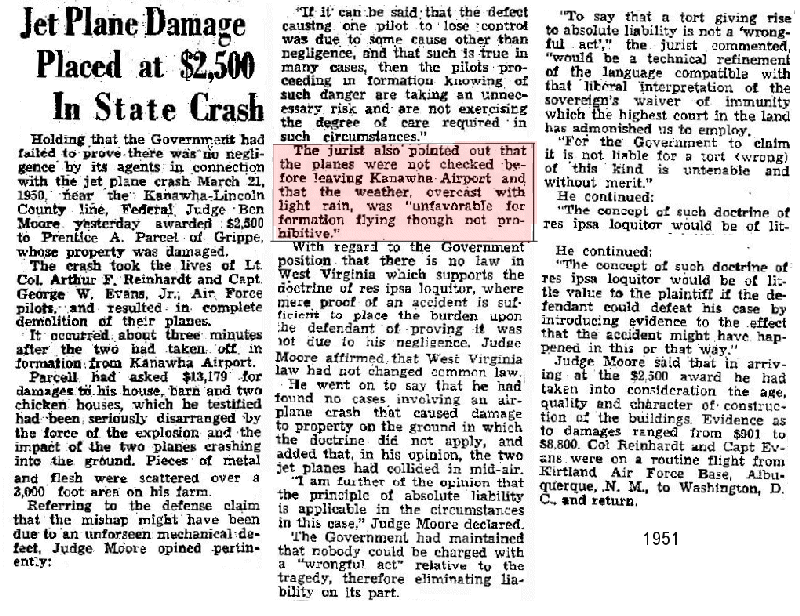
PARCELL v. UNITED STATES
November
23, 1951: On March 21, 1950, two jet fighter planes took off from
Kirtland Air Force Base, Albuquerque, New Mexico, on a routine flight
to Washington, D. C., and return. One of the planes was operated by
Lieutenant Colonel Arthur F. Reinhardt and the other by Captain George
W. Evans, Jr. Both men were pilots in the United States Air Force. One
plane had been flown a total of 101 hours; the other a total of 130
hours. Reinhardt was 45 years old. He had flown a total of 4,710 hours,
with 25 hours of actual combat time. Evans was 37 years old and had
flown a total of 2,329 hours, of which 244 hours were in actual combat.
Both pilots were qualified for instrument flying, and both planes were
equipped for such flying.
Colonel Reinhardt's last routine
physical examination was in October, 1949, and Captain Evans' in
November, 1948, at which time both were found qualified for flying. The
last known inspection of the planes was made at Kirtland Air Force Base.
Colonel
Reinhardt, who was in charge of the flight, had authority from his
superiors in the United States Air Force to plan and execute flights at
his own discretion, without clearance from any airport authority.
The
flight was made in formation, Colonel Reinhardt acting as lead pilot
and Captain Evans as wing pilot; this being standard procedure followed
in connection with routine flights of jet fighter planes, inasmuch as
one of the primary reasons for such flights is to give the pilots
training and practice in formation flying.
The planes reached
Washington, D. C., and returned as far as Charleston, West Virginia, on
the same day they took off from Albuquerque, New Mexico. They were
landed at an airport near Charleston and the pilots spent the night in
that city. At 12:17 P.M. the following day, the two planes took off in
formation from the airport near Charleston. The flight plan was that
the planes should attain and maintain an altitude of 500 feet above the
clouds, at an air speed of 500 miles per hour. The ceiling at Kanawha
Airport at noon on March 22, 1950, was approximately 3,000 feet, the
visibility was four to five miles, and there were light rain showers.
The velocity of the wind was eight to ten miles per hour, south by
southeast.
An employee of the airport traffic control system
directed Colonel Reinhardt, as flight leader, to climb at an
approximate rate of 5,000 feet per minute and to report upon leaving an
altitude of 10,000 feet. It was observed that the planes began their
flight with a normal angle of climb until they were lost to sight.
Neither Colonel Reinhardt nor Captain Evans reported after take-off.
Between two and three minutes after the take-off from the airport,
[104 F.Supp. 112]
both
planes crashed about 229 feet apart on a hillside near plaintiff's
residence and on his land, which lies approximately 15 miles south of
the airport. The evidence does not establish which plane crashed in
which spot. A line drawn between the two places of impact and extended
points approximately in the direction of the airport. Along this line
and for a distance of approximately 3,000 feet towards the airport were
scattered small parts of the wreckage of both planes, no single piece
weighing more than ten pounds. Both pilots were killed in the accident
and both planes completely demolished. There was a severe explosion and
this, coupled with flying debris, did considerable damage to the
dwelling house, the barn, and the chicken houses of plaintiff. Large
craters were created at the spot where each of the planes hit the
ground. Almost directly above each crater two sets of high tension
wires were cut.
The elevation above sea level at the airport is 985 feet. The elevation
at the site of the crash is 900 to 1,000 feet.
One
corner of the house frame was moved from the foundation wall. One side
wall was bulged out so that it had to be later supported by poles to
keep it from falling. Many of the rafters were split. The windows were
broken. Parts of the chimney and roof were damaged. The house generally
was strained and some portions of it pulled apart; but plaintiff and
his family continued to live in it up to the time of the trial The
concrete foundation of the barn was shaken and broken. One chicken
house was demolished and another damaged.
This action arises
under the Federal Tort Claims Act, 28 U.S.C.A. §§ 1346, 2671, et seq.
With certain limitations not material here, the Act makes the United
States liable for torts committed by its officers, agents, and
employees to the same extent as if it were a private person, under the
law of the place where the act or omission may have occurred.
The
complaint is founded on negligence, which plaintiff says is logically
inferrable both from the circumstances shown in evidence, and also by
use of the res ipsa loquitur doctrine. Another theory, evolved at the
trial, on which plaintiff relies, is the principle of absolute
liability for damages caused by the use of an inherently dangerous
instrumentality or by an extra-hazardous activity.
As is so
often the case in this type of accident, direct, specific, and positive
evidence pointing to what actually happened has been eliminated by the
fatal crash. There were no eyewitnesses. Tongues that might otherwise
have told were silenced. The independent circumstances left in the wake
of the accident are insufficient in themselves to charge defendant with
negligence. We must resort to a presumption or inference attached by
law to the collective circumstances; else we are left in the field of
speculation and conjecture. The doctrine of res ipsa loquitur, if
applicable, supplies this legal inference.
|
| I received an e-mail Nov. 2009 from the
grandson of Lt. Col. A.F. Reinhardt. In it he said:
Thanks
for the story. My grandfather is Arthur F. Reinhardt. He was killed
before I was born in 1955 so I never did know him. My mother and
grandmother never really spoke about it, and they had no articles or
any other information about the crash. At least now I have an idea
about what happened.
|
Arthur F. Godwin
Turlock, CA

|
Both were
F-86A-5 aircraft, with the following additional details:
48-306 with construction number 43675, delivered 9 September 1949 to
81st Fighter Group at Kirtland AFB, NM.
49-1019 with construction number 161-13, delivered 7 November 1949, to
81st Fighter Group, Kirtland AFB, NM.
|
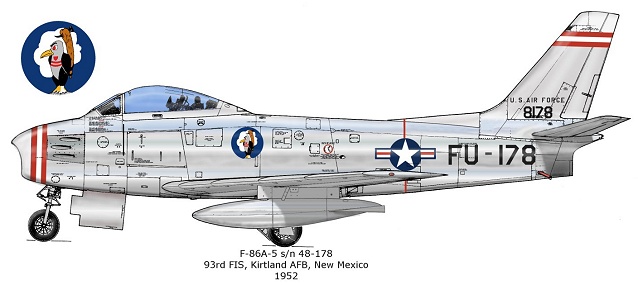
SPECIFICATIONS (F-86A):
Span: 37 ft. 1 in.
Length: 37 ft. 6 in.
Height: 14 ft. 8 in.
Weight: 13,791 lbs. loaded
Armament: Six .50-cal. machine guns and eight 5-in. rockets or 2,000
lbs. of bombs
Engine:
One General Electric J47 turbojet of 5,200 lbs. thrust
Cost: $178,000
Crew: One
PERFORMANCE:
Maximum speed: 685 mph
Cruising speed: 540 mph
Range: 1,200 miles
Combat ceiling: 49,000 ft.
|
The F-86
was developed in the 1940s following the end of World War II and was
one of the most-produced Western jet fighters in the Cold War
era. More than 6,000 F-86s were manufactured by North American's
Los Angeles, Calif., andColumbus, Ohio, divisions. The first
swept-wing airplane in the U.S. fighter inventory, the F-86 scored
consistent victories over Russian-built MiG fighters during the Korean
War, accounting for a final ratio of 10-to-1. All 39 United Nations jet
aces won their laurels in Sabres.
Forerunner
of the operational Sabre was the XF-86, first flown Oct. 1, 1947, by
North American test pilot George Welch. A few months later Welch became
the first pilot to fly the plane at Mach 1 (the speed of sound) in
routine flight. Although technically rated as subsonic, the Sabre is no
stranger to supersonic speeds. In September 1948, an F-86A set the
Sabre's
first official world speed record of 570 mph. This mark was bettered in
1952 by an F-86D that flew at 698 mph. The "D" became the first model
of a fighter to better its own record, in 1953, with a run of 715 mph.
You can contact Jerry
at.... wvskyguyATaol.com
This
page and this entire website is Copyright by mywvhome.com.
Other than the Charleston Gazette and Daily Mail articles.
Nothing is to be used without permission.
Thanks!
|
For
more history on the F-86 aircraft, click here
|







 March
22 1950 was a cloudy overcast day in the Kanawha valley with drizzle in
the air. On this day two F-86 jets were warming up at Kanawha
Airport ready for takeoff. These were the first F-86's to ever
land here, as production jets of any type had only been in
operation for about two years. The reason these jets had landed
the day before was sort of an emergency in itself: They had run
low on fuel. Because of the scarcity of jets and jet fuel,
the pilots would have to wait for fuel to be delivered from Dayton Ohio
the following day. So, Lt. Col. A.F. Reinhardt (43) and
Capt. George Evans (28) spent the night in Charleston, and even visited
the old "Press Club" during their stay.
March
22 1950 was a cloudy overcast day in the Kanawha valley with drizzle in
the air. On this day two F-86 jets were warming up at Kanawha
Airport ready for takeoff. These were the first F-86's to ever
land here, as production jets of any type had only been in
operation for about two years. The reason these jets had landed
the day before was sort of an emergency in itself: They had run
low on fuel. Because of the scarcity of jets and jet fuel,
the pilots would have to wait for fuel to be delivered from Dayton Ohio
the following day. So, Lt. Col. A.F. Reinhardt (43) and
Capt. George Evans (28) spent the night in Charleston, and even visited
the old "Press Club" during their stay. 







